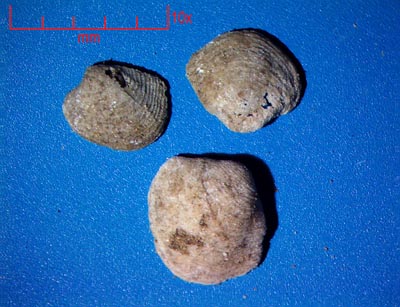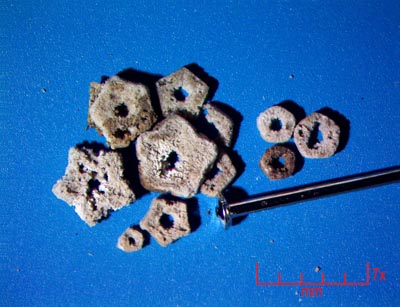|
Site 2 is
located between the second wash and the huge 4 foot stumps. It
is 100 paces long. This is the second half of Site 2, the last
50 paces. Radically different from the first half we discussed
in another posting, the fossils gleaned from the acid fines were
dominated by huge volumes of ground up shell material, to the
point of being unrecognisable bits. Mixed in were the fossils,
very small and insignificant by volume. Preservation continues
to be an issue here, the gastropods and bivalves were pitted
and broken and usually broke when trying to pick up. No ostracodes
were found, and this was a surprise. Less trilobite parts were
found, however most of a nice partial pygidium was collected.
The straparollus gastropods are now making thier appearance.
Sizes range from juviniles with only a few whorls, to larger
quarter sized specimens were in the acid bath fines. No sponge
roots or metallic particles turned up.
NOTE: Click all
images to get the larger 1290 x 960 sized image.
Bryozoans

|
We
are still a bit uncertain if these are very minute bryozoans
or a type of minscule sponge. They were found occasionally at
this site, preservation good, but not exceptional. Some of them
appear as thin walled hollow tubes. Others encrust urchin spines
and shells. More research on these is in order! |
Chonetids

|
Chonetids
are tube worms which form spiral domiciles on the surfaces of
plant material and any other hard surface. Only a few were found
at this site, but one seen here is really quite large. The one
at the bottom here has a small tube jutting straight up. Very
unusual. |

|
The
unusual chonetid seen closer. The tube is hollow as you might
expect for a home to a worm (Annellid) and you can see right
down inside here. |
Mollusks

|
The
mollusks were for the most part very poorly preserved here. A
small handful you see at the left is all we could find in the
gallon bag from this site. Surprisingly, a small Aviculopectin
was amongst them. (Left side) |

|
Parallelodon
anaklassium. The beautiful winged clam. Very thin and breakable,
always a treasure to find. |

|
Mostly
Astartella subquadrata. Very worn and hard to diagnose. |

|
Genus
and species indet. The wear and fragmented bivalves at this site
are tough to identify! |

|
This
one is VERY rare. A upper umbo of an Aviculopecten. (Think paleo
scallop) We have found only one of these ever before in over
a thousand pounds of rock. |

|
Genus
and species indet. One specimen of this shape was found. |

|
The
VERY common Astartella subquandrata. A more robust shell having
better overall preservation. |

|
This
partial fragment of a mollusk is unidentified but was so unuusal
that Ive included it here. |
Crinoids

|
Crinoids
are a small part of the fauna in this outcrop of the Fort Apache
Limestone. Here, at least two, maybe three types are seen of
crinoid ossicles (stem segments). The star shaped is usually
dominant here. The head of a pin is included for scale. |

|
Close
up of one of the star shaped ossicles. |
Rugose
Corals

|
Lophamplexus
sp. One magnificent specimen was found in the gallon of rock.
We now have four or five specimens of horn corals from this site,
all the same species and very similar in size - very tiny! |

|
End
on view of the coral. The detail in the calice is superb. To
take this photo, I drilled a hole in a black piece of wood and
dropped the coral in to hold it upright. Two dozen subframes
were stacked in Picolay with different focus to achieve this
final sharp image. |
Brachiopods

|
Pseudodielasma
sp. One of the very rarest fossils we find at this outcrop are
brachs other than productids. This large specimen was fragile
but superbly shaped. This is the pedicle valve top side. |

|
Bottom
side of the same brach. You can just see the hole for the pedicle.
(stalk) |
Gastropods

|
Preservation
was not optimal, but a few dozen good specimens were obtained.
Here is a low power view of all of them together. We will detail
some of them below. |

|
Honey
buns - Apachella prodontia. |

|
Ribbed
cones - Goniasma terebra. |

|
Smoth
Snails - Apachella sp. |

|
The
uncommon Bellerophon Gastropod showed up again in this set of
samples. Mostly intact here, this pea sized primitive mollusk
is always easy to recognise because of the dorsal ridge on its
shell and big "C" shaped aperture. |

|
Ribbed
cones - Paleostylus giganticus. |

|
Ribbed
Snails - Apachella arizonensis. |

|
Assorted
juviniles of various species. Very tiny! |
Sponges

|
More
fragments of what was a larger irregular shaped sponge are found
here. It is not known yet if the fine hair like roots found at
the previous site belong to this species. |

|
The
largest piece of sponge was pretty huge for this area. It etched
out bautifully and shows amazing detail. |
Scaphapods

|
Plagioglypta
sp. Quite a few scaphopods are now showing up, the larger ones
dominate the site. Here you can see the transverse lines on the
shells quite clearly and the smaller juviniles with their radial
ridges can be seen as well. |

|
Side
lighting of above shot to show the ridges on the shells better. |
Straparollus
Gastropods

|
Three
juviniles, the one at upper left is starting to show the square
shell cross section as it grows larger. |

|
Standing
the fine juvinile seen on the upper left image on end - You can
see the square cross section in the opening (aperture) is developing
well. |

|
The
largest Straparollus Utahensis found at this site was the size
of a quarter. Superbly detailed, it shows the inner coils developing
into the ribbed tubercles on the outer whorls. |

|
The
other side is so different - the early coils are recessed into
the body. |
Trilobites

|
Phillipsia
sp. c.f. Phillipsia perocidens. Only a few fragments were found
here, but surprisingly they are nicely detailed. The half-a-pygidium
seen to the upper right was a nice treat. The part to the upper
left is a bit enigmatic, it seems to be a smashed partial cranidium.
The three frontal cranidium ridges are seen to the left. |
Echinoids

|
Hordes
of urchin material is present here. But preservatio is really
bad. Consisting of mostly spines and plates, a few water vascular
plates were found as well. |

|
Body
plates with tubercles for mount of the spines. The urchins would
have ranged from marble sized up to maybe one inch. |

|
Poor
preservation on spines. Only a few were found intact. They are
smooth and not covered in spines. |

|
Strangely
enough, the water vascular system inlet plates were quite abundant.
Why these preserve better than other parts is unknown at this
point. |

|
This
is a genital plate, that rims the topmost part of the body of
the urchin around the periproct. The small hole is the gonopore.
We found ONE of these, which are far more common at other sites
furthur down the trail. |
Productid
Brachiopods

|
Belaclathrus
spinosus. Productid spines were rare at this site. Only a few
were found. |
 |
Belaclathrus
spinosus. Many of the productids are involved with other fossil
stuck to them when they come out of the acid. Here, the productids
underside has molluscs, a large scaphopod and some urchin material.
Its about 2 inches is size here. |
Sand,
minerals, crystals

|
There
were only a few nice crystals in this fines from this site. Here,
two stunning quartz clusters half the size of a grain of rice
were found. We did not find any mica crystals, or bright silvery
manganese. |
|
